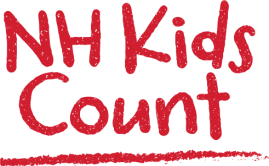Health
A child's health journey begins before they are even born, and access to quality health care in those earliest days, months, and years can shape a lifetime of outcomes. In New Hampshire, while many children have access to the care they need, significant gaps remain. From ensuring healthy births and supporting maternal mental health to expanding access to behavioral health services and immunizations, the data reveals both the challenges we face and the opportunities we have to ensure every New Hampshire child can grow up healthy, supported, and ready to thrive.
Birth Outcomes
Ensuring New Hampshire children are born healthy is fundamental to lifelong health.
- Roughly 12,000 babies are born in New Hampshire each year.1 In 2023, 1,105 (nine percent) were born before 37 weeks of pregnancy.2 While not all premature babies experience complications, premature birth can raise the risk for long-term intellectual and developmental disabilities and problems with their lungs, brain, eyes, heart, and other organs.3 In 2023, 6.7 percent of babies (805) were born weighing less than 5.5 pounds.4 Low birthweights can have long-term impacts—weighing less than 5.5 pounds at birth increases the probability of dropping out of high school and earning lower wages.5
- Ensuring pregnant women have access to prenatal health care is critical for preventing preterm births. In New Hampshire, nearly 500 babies are born each year to mothers who did not receive any prenatal care or delayed prenatal care until the third trimester.6 This is the highest in Belknap County, where the region's only birthing hospital closed its labor and delivery center in 2018. A recent study revealed that rural hospitals are 30 percent less likely to offer obstetric services after being acquired by larger hospitals, even though the number of births to women residing in the affected counties did not change.7 This means increased travel distance and expenses for pregnant women, and the likelihood of missing obstetric appointments or receiving fragmented pre- and postpartum care.
- Over the past decade, New Hampshire has experienced a substantial decline in the number of babies born to teenage mothers, reaching an all-time low of 4.2 per 1,000 births in 2022. In 2014, 484 babies were born to teen mothers, compared to 177 in 2023.8 Pregnancy in adolescence is linked with delayed prenatal care, pregnancy complications like preeclampsia, and pre-term birth, as well as higher unemployment rates, lower rates of completing education, and increased socio-economic challenges for their babies.9
Maternal Health
Healthy and happy children first need healthy moms.
- In New Hampshire, approximately 1 in 8 women experience symptoms of postpartum depression or anxiety.10 From 2018 to 2023, 39 pregnancy-related deaths were recorded in New Hampshire. Substance use, often accompanied by a co-occurring mental health disorder, was the cause for 52.5 percent of pregnancy-related deaths.11 According to the Policy Center for Maternal Mental Health, New Hampshire fails when it comes to screening new mothers for maternal mental health conditions, and also fails to offer any inpatient or residential treatment programs for maternal mental health.12
- In 2020, 42.1 percent of mothers (2,789) took paid maternity leave, while 38.7 percent (2,566) took unpaid leave.7 Studies show that women who have access to 12 weeks or longer of paid maternity leave have lower rates of postpartum depression and lower rates of depression later in life. Paid maternity leave is also linked to higher rates of breastfeeding, improved bonding, and a greater likelihood of attending well-child visits.13
- On average, approximately 1,500 pregnant women and their babies are enrolled in NH Medicaid. In 2025, almost a quarter (22 percent) of all births in New Hampshire were covered by Medicaid.14 Access to Medicaid is associated with lower rates of maternal mortality and offers access to mental health services before, during, and after birth.15
![]()
Solving Problems Through Policy Change
Momnibus 1.0 & 2.0
In 2023 and 2025, New Futures and partner organizations championed two maternal health packages to improve care for new mothers. Momnibus 1.0 extended postpartum Medicaid coverage for new moms from six weeks to 12 months, while Momnibus 2.0, which goes into effect on January 1, 2026, will: ensure maternal mental health screenings are covered by insurance at well-child visits and require private insurance plans to cover home visits. Momnibus 2.0 also protects new parents by ensuring that no employer with 20 or more employees can deny a parent leave from work for medical appointments related to birth, postpartum care, or the children’s medical appointments within the first year of birth or adoption.
Access to Insurance & Care
New Hampshire has made strides to improve access to health care for children, but 9,000 children still remain uninsured.
- Approximately one in three children in New Hampshire receives health insurance through Medicaid and/or the Children’s Health Insurance Program, while 67.4 percent are covered by private insurance. This varies widely by county - in Coos County, 44.9 percent of children are covered by Medicaid, compared to 14.7 percent of children in Rockingham County.16 9,000 children in New Hampshire do not have any health insurance coverage, including 3,000 children aged 0-5.17 Access to health care is a critical need - children need access to regular checkups, immunizations, monitoring of development, and access to care when sick. A 2016 study found that children with health insurance are generally healthier and more likely to get preventative care.18
- In 2022, 14,000 children (6 percent) lived with a parent who did not have any type of health insurance. This marked a steep decline from the prior year, when 21,000 children lived with uninsured parents.19 Insured parents are more likely to have insured children. Being uninsured can lead to mistrust of the health care system—studies show that a mother’s use of health services is a predictor of how her child will access health care and the health care system.20
- 1 in 4 children in New Hampshire (62,298) have special health care needs, such as asthma, epilepsy, autism, or sickle cell disease.21 Children and youth with special health care needs (CYSHCN) are at increased risk of chronic physical, developmental, behavioral, or emotional conditions and require additional health care services beyond what a child typically needs. Families of children with special needs have more difficulty meeting basic needs - rates of household food insufficiency are higher among children with special health care needs compared to those without: 42 percent to 31 percent. 33 percent of kids with special needs do not have adequate health insurance to meet their needs.22
![]()
Data Spotlight
Health Care Premiums for CHIP
181,000 children in New Hampshire are enrolled in New Hampshire Medicaid. Beginning in 2026, some families enrolled in the Children’s Health Insurance Program (often called New Hampshire Healthy Families) will be required to pay premiums for their insurance plans. These families can expect to pay $190-$270 monthly for their health insurance.
Immunizations
To start and stay healthy, children need access to routine immunizations.
- In 2020-21, 77.2 percent of children up to age 24 months had received all recommended doses of the seven-vaccine series: diphtheria and tetanus toxoids and acellular pertussis (DTaP) vaccine; measles, mumps and rubella (MMR) vaccine; poliovirus vaccine; Haemophilus influenzae type b (Hib) vaccine; hepatitis B (HepB) vaccine; varicella vaccine; and pneumococcal conjugate vaccine (PCV).23 A 95 percent rate is required for community immunity.
- Children attending child care centers and public schools in New Hampshire are required to have certain immunizations. Of the 175,125 children in kindergarten through 12th grade, 92.7 percent had received all the required vaccines for their age and/or grade. 5,781 children (3.3 percent) were opted out of immunizations by their parents due to religious beliefs.24
- Immunizations are a safe and cost-effective way of protecting children from preventable diseases. Children born between 1994 and 2023 will, throughout their lifetimes, be spared 508 million cases of disease, 32 million hospitalizations, and more than 1.1 million premature deaths due to vaccine-preventable diseases. However, according to the National Immunization Survey, children living below the poverty level and children who receive health insurance through Medicaid are less likely to receive immunizations compared to their peers.21
![]()
Solving Problems Through Policy Change
New Hampshire Vaccine Association
In New Hampshire, all children through the age of 18 can receive all recommended vaccines at no cost, thanks to an innovative system that combines federal funds from the Vaccines for Children (VFC) program and funding from private insurance carriers through the New Hampshire Vaccine Association (NHVA). In recent years, New Futures has worked against legislative attacks to repeal the NHVA.
Mental Health
Improving access to behavioral health services is critical to ensuring New Hampshire youth thrive.
- 1 in 3 children (67,890) in New Hampshire has one or more reported mental, emotional, behavioral, or developmental health diagnoses,25 and 39.6 percent of youth reported feeling sad or hopeless almost every day for two weeks or more. Yet, only roughly 12 percent of children saw a mental health professional in the last 12 months.26 While the percentage of youth reporting feeling sad or hopeless in 2023 declined compared to 2021, it is still higher than pre-pandemic levels.
- Suicide is the second-leading cause of death for New Hampshire youth ages 15-24. Nearly 21.3 percent have seriously considered attempting suicide, and 8.5 percent have attempted suicide at least once.28 n 2024, 15,652 calls to the 988 Crisis and Suicide Prevention hotline were for individuals 0-17 years old. Of those 15,652 calls, 6,413 required further assistance from New Hampshire’s mobile crisis team.
- Since 2015, over 1,700 children have received services through New Hampshire’s FAST Forward program, which provides wraparound mental and behavioral health treatment, services, and support to youth and their families. These programs are designed to keep children in their homes and communities. Children or youth who are involved in wraparound have better outcomes than their peers who do not receive wraparound across different areas of their lives, including mental health, and functioning in their schools, homes, and communities. Wraparound programming saves money by minimizing the time that youth spend in residential treatment centers or psychiatric hospitals, which can cost $1,000-$3,000 per day.29 More children in New Hampshire could benefit from FAST Forward if private insurance covered this service.
Policy Considerations:
To improve the health and well-being of children and families, New Hampshire should adopt policies that:
- •Create a strong network of support for new moms, caregivers, and their young children, including robust health, social, and community-based support.
- •Prioritize infant and early childhood mental health and initiatives that support healthy emotional development.
- •Create a single point of entry into the System of Care that minimizes the number of times a family has to share their story to access care.
- •Enhance and improve access to prevention services like MTSS-B, and community-based resources across the state to ensure appropriate access regardless of region.
- •Ensure the Children’s System of Care is fully funded in the state budget, including the Children’s Behavioral Health Resource Center, which provides training for providers and helps build a more robust workforce across the state.
- •Protect the New Hampshire Vaccine Association (NHVA) and other programs that provide access to childhood vaccines.
References
- Total births | KIDS COUNT Data Center. (2025, January). Retrieved August 8, 2025, from https://datacenter.aecf.org/data/tables/6052-total-births?loc=31&loct=2#detailed/2/31/false/2545,1095,2048,574,1729,37,871,870,573,869/any/12720
- Preterm births | KIDS COUNT Data Center. (2025, January). Retrieved August 8, 2025, from https://datacenter.aecf.org/data/tables/18-preterm-births?loc=31&loct=2#detailed/2/31/false/2545,1095,2048,574,1729,37,871,870,573,869/any/279,280
- Premature birth - Symptoms and causes. (n.d.). Mayo Clinic. https://www.mayoclinic.org/diseases-conditions/premature-birth/symptoms-causes/syc-20376730
- Low birthweight babies | KIDS COUNT Data Center. (2025, January). Retrieved August 26, 2025, from https://datacenter.aecf.org/data/tables/5743-low-birthweight-babies?loc=31&loct=2#detailed/2/any/false/1096,1095,2048,574,1729,37/any/12351,12352
- Born To Lose: How birth weight affects adult health and success. (2007, June 5). University of Michigan. Retrieved August 26, 2025, from https://news.umich.edu/born-to-lose-how-birth-weight-affects-adult-health-and-success/
- Births premature and delayed or no prenatal care | KIDS COUNT Data Center. (2025, January). Retrieved August 8, 2025, from https://datacenter.aecf.org/data/tables/10299-births-premature-and-delayed-or-no-prenatal-care?loc=31&loct=2#detailed/2/any/false/2545,2048,574,870/6374,6375|6273/19929
- Geddes, D. D. M. G. E. (2025). Expecting harm? The impact of rural hospital acquisitions on maternal health care. NBER. https://doi.org/10.3386/w34159
- Teen births | KIDS COUNT Data Center. (2025, February). Retrieved August 8, 2025, from https://datacenter.aecf.org/data/tables/8788-teen-births?loc=31&loct=2#detailed/2/any/false/2545,1095,2048,574,1729,37,871,870,573,869/any/17632,17633
- Pregnancy before 16 increases long-term health complications for girls and babies | Pediatrics | Your Pregnancy Matters | UT Southwestern Medical Center. (n.d.). https://utswmed.org/medblog/early-teen-pregnancy-health-risks/
- New Hampshire Fiscal Policy Institute. (2025a, May 7). Metrics for Mother’s Day: Granite State Edition. Retrieved August 26, 2025, from https://nhfpi.org/blog/metrics-for-mothers-day-granite-state-edition/
- NH Department of Health and Human Services, Maternal & Child Health Section. (2024). 2023 New Hampshire Annual Report on Maternal Mortality. Retrieved August 25, 2025, from https://www.dhhs.nh.gov/sites/g/files/ehbemt476/files/documents2/2023-annual-nh-report-on-maternal-mortality.pdf
- State Report Cards - Policy Center for Maternal Mental Health. (2025, November 5). Policy Center for Maternal Mental Health. https://policycentermmh.org/state-report-cards/
- The case for national paid maternity leave. (2025, June 18). News Center. https://med.stanford.edu/news/insights/2020/05/the-case-for-national-paid-maternity-leave.html
- Kaiser Family Foundation. (2025). Medicaid in New Hampshire. In Kaiser Family Foundation. Retrieved August 26, 2025, from https://files.kff.org/attachment/fact-sheet-medicaid-state-NH
- Medicaid cuts could increase maternal mortality and jeopardize women’s health. (2025, May 20). The Commonwealth Fund. Retrieved August 26, 2025, from https://www.commonwealthfund.org/blog/2025/medicaid-cuts-could-increase-maternal-mortality-and-jeopardize-womens-health
- Children’s health insurance coverage by type | KIDS COUNT Data Center. (2025, January). Retrieved August 12, 2025, from https://datacenter.aecf.org/data/tables/10304-childrens-health-insurance-coverage-by-type?loc=31&loct=2#detailed/2/any/false/2545,2048,1729,870/1361,3151,3452,3453/19935
- Children without health insurance by age group | KIDS COUNT Data Center. (2024, September). Retrieved August 12, 2025, from https://datacenter.aecf.org/data/tables/10184-children-without-health-insurance-by-age-group?loc=31&loct=2#detailed/2/31/false/2545,1095,2048,1729,37,871/8121,20,21/19708,19709
- Amanda Kreider, Benjamin French, and Jaya Aysola, "Quality of Health Insurance Coverage and Access to Care for Children in Low-Income Families," JAMA Pediatr (2016), http://jamanetwork.com/journals/jamapediatrics/fullarticle/2470859.
- Children who have a parent with no health insurance | KIDS COUNT Data Center. (2024, January). Retrieved August 12, 2025, from https://datacenter.aecf.org/data/tables/6547-children-who-have-a-parent-with-no-health-insurance?loc=31&loct=2#detailed/2/31/false/1095,2048,1729,37,871,870,573,869,133,38/any/13533,13532
- National Academies Press (US). (2002b). Family Well-Being and Health Insurance coverage. Health Insurance Is a Family Matter - NCBI Bookshelf. Retrieved August 12, 2025, from https://www.ncbi.nlm.nih.gov/books/NBK221008/
- Children with special health care needs | KIDS COUNT Data Center. (2025, April). Retrieved August 12, 2025, from https://datacenter.aecf.org/data/tables/9703-children-with-special-health-care-needs?loc=31&loct=2#detailed/2/31/false/2490,2105,2043,1769,1696,1648,1603/any/18949,18950
- The Annie E. Casey Foundation. (2024, July 14). Children with disabilities and special health care needs. https://www.aecf.org/blog/the-state-of-children-with-disabilities-and-special-health-care-needs
- Explore childhood immunizations in New Hampshire | AHR. (n.d.). https://www.americashealthrankings.org/explore/measures/Immunize_c/NH
- NH Immunization Program: 2024/2025 Annual School Immunization Report. (2025). In New Hampshire Department of Health & Human Services. Retrieved August 27, 2025, from https://www.dhhs.nh.gov/sites/g/files/ehbemt476/files/documents2/24-25-nh-school-immunization-report.pdf
- Children who have one or more emotional, behavioral, or developmental conditions | KIDS COUNT Data Center. (2025, April). Retrieved August 12, 2025, from https://datacenter.aecf.org/data/tables/10668-children-who-have-one-or-more-emotional-behavioral-or-developmental-conditions?loc=31&loct=2#detailed/2/31/false/2490,2105,2043,1769,1696,1648,1603/any/20457,20456
- Zablotsky, B., & Ng, A. (2023). Data Brief 472: Mental health treatment among children aged 5-17 years: United States, 2021: Older children were more likely than younger children to have received any mental health treatment. https://doi.org/10.15620/cdc:128144
- High school students who seriously considered attempting suicide. (n.d.). Youth Risk Behavior Survey | CDC. Retrieved August 12, 2025, from https://yrbs-explorer.services.cdc.gov/#/graphs?questionCode=H27&topicCode=C01&location=NH&year=2023
- High school students who actually attempted suicide. (n.d.). Youth Risk Behavior Survey | CDC. Retrieved August 12, 2025, from https://yrbs-explorer.services.cdc.gov/#/graphs?questionCode=H29&topicCode=C01&location=NH&year=2023
- National Wraparound Initiative. (2024, July 20). Wraparound Basics or What is wraparound: an introduction. National Wraparound Initiative (NWI). https://nwi.pdx.edu/wraparound-basics/#whywrap




